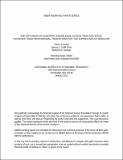The Diffusion of Scientific Knowledge across Time and Space
Author(s)
Graff Zivin, Joshua S.; Sampat, Bhaven N.; Azoulay, Pierre
Downloadw16683.pdf (861.6Kb)
OPEN_ACCESS_POLICY
Open Access Policy
Creative Commons Attribution-Noncommercial-Share Alike
Terms of use
Metadata
Show full item recordAbstract
This chapter discusses the consequences of academic mobility and the extent to which the movement of high-achieving faculty members affects both scientific and commercialization activities at their old and new schools. It looks at articles published by, and patents granted to, the mobile scientist before they departed for the new school, comparing these to similar outputs by scientists who did not move. The heterogeneity that can distort simpler comparisons can be limited. The analysis suggests that the citations to a departing scientist's articles from the university where he or she departs are barely affected by the move. However, citations to the departing scientist's patents (whether made in articles or patents) decline sharply at the originating school. This suggests that the physical proximity of the researcher is important to ensuring knowledge flows to industry. Citations to the scientist's work at his or her new location increase dramatically once the move is complete. Barriers to scientific mobility may actually be socially detrimental, as they prevent the kind of knowledge gains from the mixing of ideas. Keywords: diffusion; scientific knowledge; professional transitions; academic mobility; physical proximity; researcher
Date issued
2013-02Department
Sloan School of ManagementJournal
The Rate and Direction of Inventive Activity Revisited
Publisher
Oxford University Press
Citation
Azoulay, Pierre et al. “The Diffusion of Scientific Knowledge Across Time and Space.” The Rate and Direction of Inventive Activity Revisited (2012): 107–155 © 2011 The Authors
Version: Original manuscript
ISBN
9780226473031